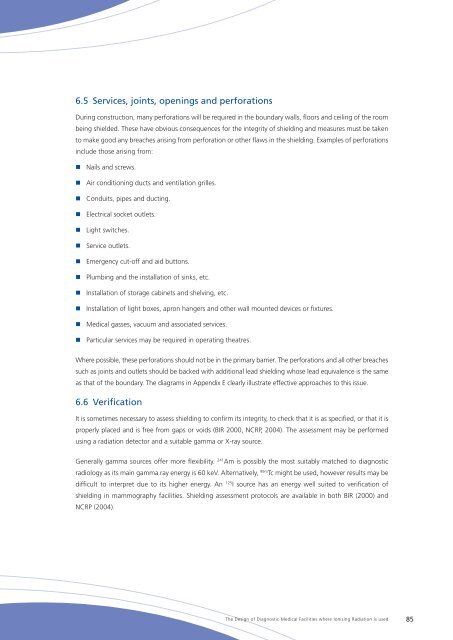The Design of Diagnostic Medical Facilities where ... - ResearchGate
The Design of Diagnostic Medical Facilities where ... - ResearchGate
The Design of Diagnostic Medical Facilities where ... - ResearchGate
You also want an ePaper? Increase the reach of your titles
YUMPU automatically turns print PDFs into web optimized ePapers that Google loves.
6.5 Services, joints, openings and perforations<br />
During construction, many perforations will be required in the boundary walls, floors and ceiling <strong>of</strong> the room<br />
being shielded. <strong>The</strong>se have obvious consequences for the integrity <strong>of</strong> shielding and measures must be taken<br />
to make good any breaches arising from perforation or other flaws in the shielding. Examples <strong>of</strong> perforations<br />
include those arising from:<br />
• Nails and screws.<br />
• Air conditioning ducts and ventilation grilles.<br />
• Conduits, pipes and ducting.<br />
• Electrical socket outlets.<br />
• Light switches.<br />
• Service outlets.<br />
• Emergency cut-<strong>of</strong>f and aid buttons.<br />
• Plumbing and the installation <strong>of</strong> sinks, etc.<br />
• Installation <strong>of</strong> storage cabinets and shelving, etc.<br />
• Installation <strong>of</strong> light boxes, apron hangers and other wall mounted devices or fixtures.<br />
• <strong>Medical</strong> gasses, vacuum and associated services.<br />
• Particular services may be required in operating theatres.<br />
Where possible, these perforations should not be in the primary barrier. <strong>The</strong> perforations and all other breaches<br />
such as joints and outlets should be backed with additional lead shielding whose lead equivalence is the same<br />
as that <strong>of</strong> the boundary. <strong>The</strong> diagrams in Appendix E clearly illustrate effective approaches to this issue.<br />
6.6 Verification<br />
It is sometimes necessary to assess shielding to confirm its integrity, to check that it is as specified, or that it is<br />
properly placed and is free from gaps or voids (BIR 2000, NCRP, 2004). <strong>The</strong> assessment may be performed<br />
using a radiation detector and a suitable gamma or X‐ray source.<br />
Generally gamma sources <strong>of</strong>fer more flexibility. 241 Am is possibly the most suitably matched to diagnostic<br />
radiology as its main gamma ray energy is 60 keV. Alternatively, 99m Tc might be used, however results may be<br />
difficult to interpret due to its higher energy. An 125 I source has an energy well suited to verification <strong>of</strong><br />
shielding in mammography facilities. Shielding assessment protocols are available in both BIR (2000) and<br />
NCRP (2004).<br />
<strong>The</strong> <strong>Design</strong> <strong>of</strong> <strong>Diagnostic</strong> <strong>Medical</strong> <strong>Facilities</strong> <strong>where</strong> Ionising Radiation is used 85
















